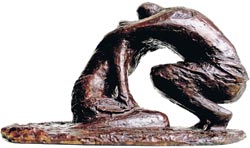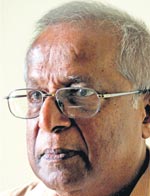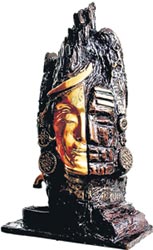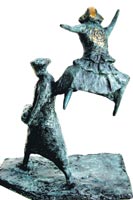
Moulding foreverWalking down life's path of renowned
sculptor Tissa Ranasinghe, Kumudini
Hettiarachchi relates his untiring journey Debris…..amidst the debris, a clenched fist juts out startlingly encapsulating the devastation of the December 2004 tsunami, in a simple square of bronze while in another heavier work a couple embrace each other, not in sexual intimacy, but with all body lines depicting grief and despair. Seated amidst bronze sculptures lying here and there, a totally relaxed “national treasure” as another well-known artist dubbed him, 82-year-old Tissa Ranasinghe, in khaki shorts and bush shirt, talks about his life and his passion. Art was not his life or his passion in childhood. The only art he remembers is the art teacher putting a shoe flower in a glass of water and asking the little boys to draw that. But when he was 10, he did see a cousin, Chitra Ratnayake, creating a two-piece mould of a duck from plaster of Paris, after reading about it in the paper.
“Unconsciously, it must have stuck in my mind because that work of art came back to me years later,” he chuckles. In his teenage years looking for something to do, with his two elder brothers already well ahead in their career paths, one as a lawyer and the other into a science degree, Mr. Ranasinghe took the easy way out. Thinking that agriculture would not burden him with much study, off he went to the Tropical School of Agriculture in Peradeniya. He was, however, in for a shock. “You name it and we had to do it,” he says. They covered a range of studies including geology, plant pathology, horticulture etc. Drawing was an essential part of it. Not only did he draw plants and other stuff needed for the agriculture course but also female figures, in popular demand, on the lockers of his batchmates. “Of course, they were not nude,” he smiles. He was also good in calligraphy and the “Principal shut me up in a room and asked me to write all the certificates”, before the group passed out of the school. Still not finding his feet or the dexterity of his fingers, he took up his first job at the Botany Section of the Department of Agriculture, going on to the Peradeniya Botanical Gardens, later moving to Maha Illuppallama and back again to the hill country trying his hardest to coax farmers in Patha Dumbara to adopt new cultivation methods. The farmers were not interested and in exasperation he quit his job.
“There was something simmering inside me,” he says. That was when he decided to go to Art School. Many thought he was mad, with one aged relative even suggesting that he should be tied to the cart because he had horns. As is usual in Sri Lanka, Mr. Ranasinghe went along with a relative who knew the Art School head, J. D. A. Perera. On being told at the Technical College, Maradana, where the Art School was, that Mr. Perera had gone to Mahiyanganaya, they set off in hot pursuit, catching up with him just as Mr. Perera was crossing the river on a beautiful moonlit night, recalls Mr. Ranasinghe. No questions were asked when Mr. Ranasinghe’s request was told to Mr. Perera. The only words were: “Come on Wednesday.” Those were the words that launched him on a career that would bring him not only fame but also fulfilment. Painting and drawing followed and as Mr. Perera was also arts advisor to the government, he entrusted young Ranasinghe with a few jobs including drawing recruitment posters for the Army, Air Force and Police. “I was paid the princely sum of Rs. 50 a poster, when my school needs, travel and other sundry costs came to about Rs. 20 a month,” he says. Well into their course, two of them were summoned by Mr. Perera who informed them that there were lots of good painters but no sculptors. The other youth was George Beven. “At the sculpture department we met Mrs. Rathi Dhanapala (wife of well-known editor D. B. Dhanapala and mother of Nihalsinghe) who was not only a good teacher but a good looking lady too,” he says. They were set the task of copying the model of David’s hands and David’s feet. “We had to use clay and George got fed up,” he laughs. George left sculpture, achieving success after success in painting. A challenge came up – the students had to make a sculpture and the best creator would win a two-year scholarship to England and come back to head the department. Mr. Ranasinghe was among the four short-listed. “As usual I thought mine was good,” he says. But it didn’t work out the way he thought and someone else was chosen.
That was when Mr. Ranasinghe set his sights on England. He was determined to go abroad and “became somewhat of a nuisance to those around me”. His mother and two brothers, Parinda (former Chief Justice) and Mahesa, paid his passage to England. It was to the Chelsea School of Art that he went and in two weeks he was vindicated. “Both my Professors, Bernard Meadows and Willi Soukop, wrote to the Sri Lankan government and also to the British Council in England that I deserved a scholarship.” But he didn’t get one. In the fourth year, he got the first UNESCO Fellowship awarded to Sri Lanka under the creative artist category and stayed on for more studies, securing a diploma before heading back to Sri Lanka, now competent in handling works in terracotta, wood and cement. Reminiscences flow on the first two benefactors. Famous architect Geoffrey Bawa commissioned him to do the mythical bird Kinnara in plaster of Paris for the Blue Elephant night club and Rev. Lakdasa de Mel wanted two sculptures for the Kurunegala Cathedral, the crucifixion and the head of Christ for a 30-foot Christ in majesty, both in cement. People had told Rev. de Mel that the head of Christ looked like his and he wanted Mr. Ranasinghe to change that. “I told him that the only way I could do that was to break the head of Christ and replace it with a new one,” says Mr. Ranasinghe. Up on a scaffolding, about to break the statue, the mason assigned to him says he’s a Muslim, getting the quick answer from Rev. de Mel that “a Muslim breaks the head of Christ and a Buddhist makes it”. It was the year 1959, with Mr. Ranasinghe all set to hold his first exhibition in Colombo. Frenetic activity at the Lionel Wendt, when someone brings the news that an important person had been shot. It was September 29, 1959. The exhibition is opened and then closed soon after, for Prime Minister S.W.R.D. Bandaranaike is the victim. The exhibition is finally held a month later. Working only in terracotta, wood and cement, Mr. Ranasinghe had developed an interest in bronze casting, looking around for training opportunities. Unlike clay or any other material, bronze lasts practically forever, he says. However, bronze casting was done only in commercial foundries and though he applies to many in the UK and India “they don’t want to teach because then the student opens a foundry of his own”. But his break comes when he hears that a professor at Art School had got together with two Italians and opened up a bronze foundry at the Royal College of Art in London. Things work out once again with former links coming into play.
Once again money was an issue – and once again comes help in the form of a promise from the Director of the Asia Foundation who tells him that if the costs are below Rs. 10,000 he would be able to fund it. So armed with a cheque for Rs.9, 995 he leaves for England, the first student to be taken in as an apprentice. For a few months he does nothing….except “sweep the floor, make the tea, wash the brushes like during the time of the Renaissance”, he says. But it pays off, for they were testing him to see whether he was made of the stuff that would endure. That was also the time he married Sally Cooper, a British girl. What was the reaction of his parents? They were fine. The only thing his mother told him was: “Aagamata pitipassa harawanna epa.” (Don’t turn your back on your religion). After training in bronze casting it was back to Sri Lanka not only working in his home country but also setting up a bronze foundry in his village of Yogiyana, close to Sandalankawa. “It was just a thatched place,” says Mr. Ranasinghe. For 10 years, he cast the trophies for the Sarasavi Awards and still does.“There is a traditional home-based industry coming down the ages, but these bronze workers cast a figure and work on all the decorations by hand. The figures are also small,” he says. Yes, he believes that he was the first Sri Lankan to do large bronze figures. Now Dr. Sarath Chandrajeewa also does them, he adds.
Mr. Ranasinghe fell on hard times….not with regard to money but finding it difficult to buy machines and materials during the early 1970s. “You had to apply to buy a drill and then wait for six months to get.” The time had come for him to make a decision and it was back to England with his family, now a larger one with a son and a daughter, where he joined the college he had trained in taking over the reins from his retiring Italian Professor. But Sri Lanka has always been home and special and large bronzes all over Colombo and one even in Galle are solid testimonies to his affinity to his motherland. Passing the old Parliament building, ever wondered who made the statue of D. S. Senanayake. “There was a statue there, but the authorities at that time, way back in 1958 were not pleased with it and wanted it changed and wanted a new one done.” Mr. Ranasinghe who was a student in England at that time wrote a letter to the Observer that he would take up the challenge, if someone would pay for the material. Well-know Editor of yore Tarzie Vittachi did just that – setting up a fund through the newspaper and collecting Rs.14,000 ££(1,000 pounds at that time). The professors in England allowed Mr. Ranasinghe to use the foundry free of charge. When the statue was cast, the government had changed and it was several years before the statue was erected there, with the earlier statue, done by an Englishman being taken to Independence Square. “Finally when it was installed, I was not even invited to the ceremony but was part of the curious spectators watching what was happening before I was spotted and invited to tea by the then Speaker ………….,” says Mr. Ranasinghe without rancour. He has also cast the statues of former Governor-General Oliver Goonetilleke - which can be seen on the way to Parliament - and those of the Prime Ministers Dudley Senanayake, S. W. R. D. Bandaranaike and Sir John Kotelawela and also the statue of Henry Steele Olcott in the middle of market square in Galle. “Many are the busts of the good and the great he has done,” he says. Special are the busts of H. W. Rupesinghe, Romulus de Silva, and Annie Boteju he has done because, usually people pay the sculptor but in these instances he had to pay them to sit for him. There’s nothing new in what he does but it is the re-interpretation that makes it different. He has also gone into Buddhism – sculpting three incidents in the life of the Buddha: Self-mortification, Maara Uddaya and Enlightenment. The Enlightenment bronze shows the Buddha emerging from darkness to light, he says. Most of Tissa Ranasinghe’s bronzes show animal figures, especially the bull and the buffalo. “May be because I’m a Taurus and a relative said I needed a pair of horns,” he laughs, explaining that Sri Lankans are adept at casting figures of bulls, buffaloes and elephants but find it difficult with horses because “we don’t see them on our road”. And what is his favourite work? “The one I still have to do.” |
|| Front
Page | News | Editorial | Columns | Sports | Plus | Financial
Times | International | Mirror | TV
Times | Funday
Times || |
| |
Copyright
2007 Wijeya
Newspapers Ltd.Colombo. Sri Lanka. |



